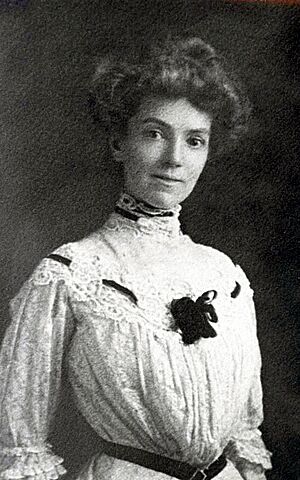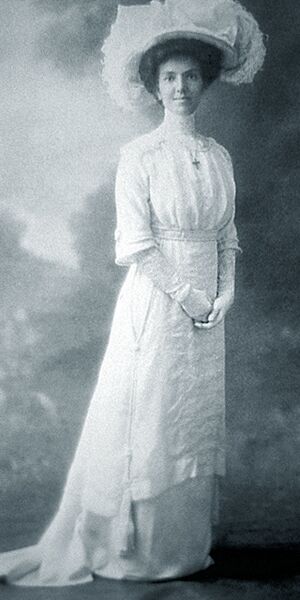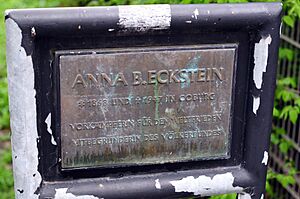Anna B. Eckstein facts for kids
Quick facts for kids
Anna B. Eckstein
|
|
|---|---|

Eckstein c. 1907
|
|
| Born |
Bernhardine Anna Eckstein
14 June 1868 |
| Died | 16 October 1947 (aged 79) Coburg, American zone, Occupied Germany
|
| Known for | Peace activism |
Anna Bernhardine Eckstein (born June 14, 1868 – died October 16, 1947) was a German woman who worked tirelessly for world peace. She was a teacher who traveled all over the world to share her ideas. Anna collected six million signatures for a special request, called a petition. In 1913, she was even nominated for the Nobel Peace Prize. Her plans were stopped by World War I, but her ideas later helped create the Kellogg–Briand Pact in 1928.
Contents
Early Life
Anna Eckstein was born on June 14, 1868, in Coburg, Germany. Her father worked for a railway company. Anna had a younger brother, Ernst, and an older sister, Antonie. Because of money problems, Anna only went to a girls' school from 1874 to 1882.
However, her teacher, Ottilie Frese, helped her learn English and French. This made Anna want to become a teacher herself. In 1882, she was confirmed in the main church of Coburg.
Moving to America
When Anna was 16, in September 1884, she moved to New York to visit relatives. It's not fully clear why she moved. Maybe her parents wanted to stop her from dating someone from a higher social class. Or perhaps it was to help her teaching career.
For a few years, she worked as a maid and a teacher. Then, she became a private teacher for the daughter of a Jewish merchant named Godfrey Mannheimer. She worked for the Mannheimer family from 1887 to 1893. During this time, she traveled with them on three trips back to Germany.
Working for Peace
In 1894, Anna Eckstein moved to Boston. She lived with a writer named Martha "Mattie" Griffith Browne and continued working as a teacher. Anna was disappointed with the results of the Hague Peace Conferences. These were meetings where countries tried to agree on rules for war and peace.
Because of this, she joined the American Peace Society. She became a vice president of this group from 1905 to 1911.
The World Petition
Before the second peace conference in The Hague, Anna wrote a proposal. She collected over one million signatures from people in the US, UK, and Germany who supported her idea. On July 4, 1907, she gave this document to the conference leader.
Anna didn't think the agreements from this second conference were good enough. So, she decided to organize her own effort, paying for it herself. She collected six million signatures for a new petition! She planned to present this huge petition at the third Hague peace conference in 1914.
However, World War I started, which stopped her plans. This was a big setback for her. But her ideas were very important. They later influenced the Kellogg–Briand Pact of 1928. This pact was an agreement where many countries promised not to use war to solve problems.
Traveling for Peace
With help from an American publisher named Edwin Ginn, Anna traveled through Canada and Europe. She wanted to spread her ideas about peace. In 1909, she went to the second National Peace Congress in Chicago, USA. There, she read her "World Petition to the Third Hague Conference."
That same year, she moved back to her hometown of Coburg. From there, she kept traveling to most European countries. She also visited Australia, New Zealand, Japan, and China. She gained more and more support for her cause. Anna often wore white dresses as a symbol of peace.
She worked with other famous peace activists like Bertha von Suttner and Alfred Hermann Fried. Even though she faced some opposition, especially in France and Germany, her work was recognized. In 1913, she was nominated for the Nobel Peace Prize.
During World War I
During World War I, Anna Eckstein wrote articles for a magazine about international law. She also published a book called Staatenschutzvertrag zur Sicherung des Weltfriedens. This title means State Protection Treaty to Preserve World Peace.
Later Life and Death
After World War I ended, Anna Eckstein worked with the Deutsche Liga für den Völkerbund. This was the German branch of the League of Nations, an organization created to promote peace. She helped set up local groups, including one in Coburg.
Anna was very active in trying to stop the rise of National Socialism (the Nazi party) in her hometown. She also helped start a local group for the German Democratic Party. She helped create an adult education center, a community club, and a literature and music society. Besides all this, Anna was active in the Protestant church. She was a member of the state synod, which is a church council.
Anna stayed in Switzerland from March to September 1933. Then she returned to Coburg. She kept writing letters to remind people about the Kellogg–Briand Pact. In 1942, she tried to publish a book called "The Will to Power Harmonized." But the Nazi government, led by Goebbels, would not let her publish it.
Anna Eckstein died on October 16, 1947, at her home in Coburg.
Legacy
The city of Coburg honored Anna Eckstein and her achievements. In 1987, they named a green space after her.
In 2013, a primary school in Meeder was renamed the Anna-B.-Eckstein-Schule. This school has a peace museum on its ground floor. It also has a special room dedicated to Anna Eckstein's life and work.
See Also
- List of peace activists



